
Associate Ophiopogon
5 ideas for pairing Japanese Lily of the Valley
Contents
The Ophiopogon, also known by various common names such as Blue Herb, Snake’s Beard, Dragon’s Beard, or Japanese Lily of the Valley, is a perennial with fine, elongated foliage, which visually resembles grasses. Its discreet flowering, with bell-shaped blooms that mimic those of lily of the valley, ranges from white to violet tones, followed by small blue-hued berries. However, it is primarily valued for its graphic and decorative foliage. The typical species has solid green leaves, while some varieties display a dark purple so deep it appears black. Growing slowly, it forms a very decorative evergreen groundcover and adapts to all exposures, provided the soil is not too calcareous. With commendable hardiness, it requires no maintenance. Although highly aesthetic, it would be a shame to grow it alone. The ideal is to use it to highlight well-chosen companions. From plants with beautiful foliage to those with fragrant flowers, as well as colourful barks and decorative berries, the options are vast. In this article, I propose 5 ideas for pairing Ophiopogon. You will find suggestions for creating decorative displays in every season, whether you grow Japanese Lily of the Valley in the ground or in pots on your terrace.
Colourful and Fragrant Winter Display
Ophiopogon planiscapus ‘Nigescens’, or black Ophiopogon, is a variety that creates striking contrasts throughout winter. Some trees and bushes, once their leaves have fallen, display colours of great richness, highlighted by the intense black of this beautiful groundcover. Japanese maples, such as Acer ‘Sango Kaku’ with its reddish-orange wood, or Acer ‘Bi-hoo’, bright yellow, contrast beautifully against this dark backdrop. Other essential stars include decorative Dogwoods with intensely coloured stems (reds, oranges, yellows…). We can also mention certain Willows, ornamental Cherry trees like Prunus serrula (mahogany bark) or Prunus maackii ‘Amber Beauty’ (coppery bark). The white of a Betula jacquemontii or a decorative bramble like Rubus ‘Silver Fern’ also creates a striking effect. To accompany them, consider conifers, some dwarf forms of which can fit into small gardens. Their colours are much more varied than one might think, and their shades can also change with the seasons. Don’t forget winter flowering, fragrant shrubs like Hamamelis, Mahonia, Daphne, Sarcococca, winter Honeysuckle, or Bodnant Viburnum. Then, simply complete with perennials that also reveal their corollas in this season (hellebore, heather, bergenia…) and ornamental grasses with decorative and evergreen foliage like Carex, Fescue, or Luzula. To make the picture truly complete, you cannot overlook early flowering bulbs (snowdrop, Chionodoxa, Crocus, Ipheion, reticulate Iris or Algerian Iris…).
–> Discover without delay our advice sheets for a beautiful winter garden.
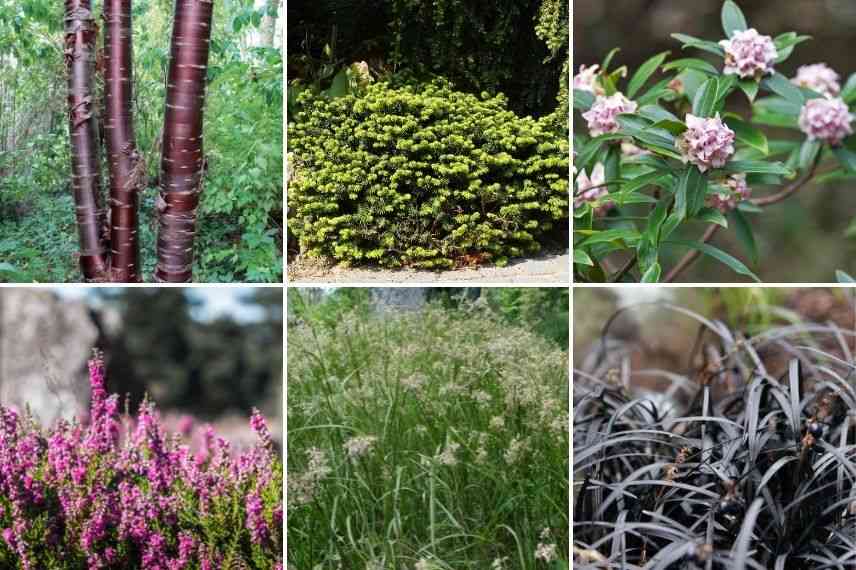
Prunus serrula (photo Esther Westerveld), Abies balsamea ‘Nana’, Daphne, Heather, Luzula sylvatica (photo Wikipedia) and Ophiopogon planiscapus ‘Nigescens’
In the shade, under the trees
The Ophiopogon thrives perfectly in shaded situations, such as those found in certain parts of the garden, under deciduous trees. Due to the less bright light, a green-leaved species, like Ophiopogon chingii, stands out better than another with darker foliage. This Turquoise Herb elegantly and naturally dresses the base of bushes such as Sarcoccocas, which have evergreen foliage and very fragrant winter flowering. To bring in some light, play with the variegated green and yellow foliage of an Aucuba ‘Golden King’, for example. To see it bear fruit and adorn itself with small red berries, pair it with the variety ‘Rozannie’, which will pollinate it and also bear fruit. To vary the shapes of foliage and textures, Mahonia varieties like ‘Charity’ or ‘Winter Sun’ are also evergreen and produce upright clusters of fragrant yellow flowers in winter. With a softer appearance, Mahonia ‘Soft Caress’ seems to have borrowed its foliage from a fern. Once the bushes are established in the background, add some perennials that thrive in shaded situations. Geranium macrorrhizum forms carpets of evergreen foliage. Drought-resistant and hardy, it limits the growth of unwanted plants, flowers in late spring, and has no problem growing among tree roots. Bright clumps of variegated Liriopes like ‘Silvery Sunproof’ or ‘Silver Dragon’ take over between summer and autumn, with flowers in blue tones. Still in the realm of low and decorative foliage, feel free to rely on that of Carex. Finally, among some Hellebores with their irresistible winter flowering, insert bulbs such as Cyclamens, which bloom from late winter to autumn depending on the species.
–> All our advice sheets for planting in shade in the garden.
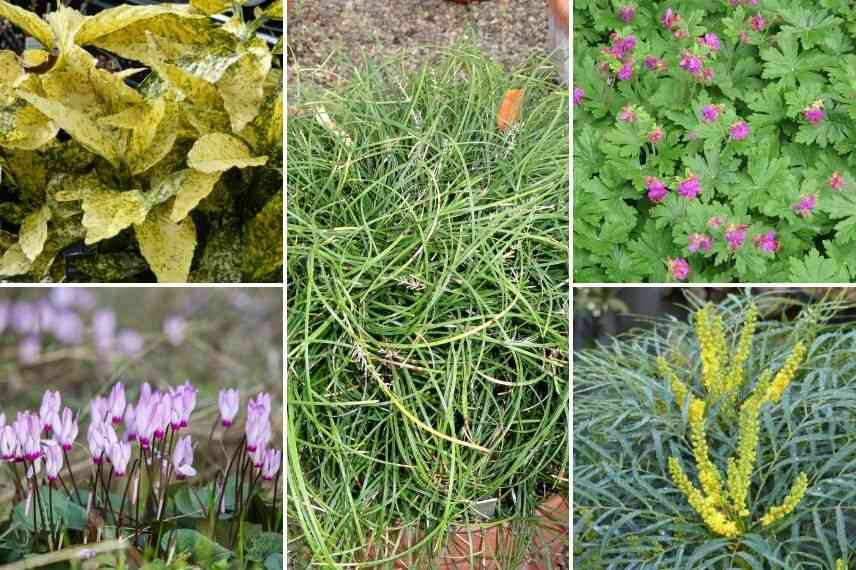
Aucuba japonica ‘Golden King’, Ophiopogon chingii (photo Daderot – Wikimedia), Geranium macrorrhizum ‘Bevan’s Variety’ (photo Wikipedia), Cyclamen hederifolium and Mahonia ‘Soft Caress’
Discover other Ophiopogon
View all →Available in 2 sizes
Available in 1 sizes
Available in 2 sizes
Available in 2 sizes
Available in 1 sizes
Available in 1 sizes
Available in 3 sizes
Available in 2 sizes
Available in 1 sizes
Available in 1 sizes
An elegant border, beautiful all year round!
The evergreen foliage of Ophiopogon allows for the creation of neat borders all year round. Among the varieties with black foliage, Ophiopogon ‘Nigrescens’ has a more flexible and elongated habit compared to Ophiopogon ‘Hosoba Kokuryu’, which is more upright. In both cases, pair them for example with other border plants with light or variegated foliage such as Hakonechloa or Carex, two grasses that are full of roundness and grace. Also excellent candidates are Heucheras with grey or silver foliage, such as Heuchera ‘Silver Gumdrop’ or ‘Sugar Plum’. The green of Ophiopogon planiscapus is also suitable for bordering a flowerbed or path. Since it pairs well with all other shades, you can certainly combine it with Heucheras in bolder colours. Deep pink for Heuchera ‘Georgia Plum’, bright orange of Heuchera ‘Carribean Sea’, olive green blended with rosy purple and silver in Heuchera ‘Cappuccino’, or even variegated with varieties such as ‘Velvet Night’ or ‘Mint Julep’. Of course, perennials with long flowering periods will enrich your display. Erigeron karvinskianus is known to love the sun, but it blooms perfectly well in partial shade, and its small daisy-like flowers create profuse flowering domes for nearly 6 months of the year. The various bluish shades of the small campanulas add depth, unless you prefer the lavender pink of a Campanula of the Walls ‘Lisduggan Variety’, or the pure white of a Carpathian Campanula ‘Clips’.
–> Want an elegant border? Our articles to guide you.

Ophiopogon ‘Hosoba Kokuryu’, Erigeron karvinskianus, Carpathian Campanula white ‘Clips’ and Heuchera ‘Sugar Plum’
A Japanese-inspired garden
Japanese Lily of the Valley, due to its Asian origins, is commonly used in Japanese or Zen-style landscaping. For a successful atmosphere, the choice of plants is important. A cloud-pruned bush provides structure and a sense of timelessness. Many Pines and crenate Hollies are well-suited to this art of Niwaki. You can also combine them with conifers with a more natural habit. Of course, a Japanese Maple with its finely cut and colourful foliage pairs perfectly with the delicate strands of Ophiopogon, as do many other decorative foliage shrubs like Nandina, Fatsia, Mahonia, or Pieris. Flowers, added in small touches, can also be part of the decor. Camellias, Rhododendrons, and Azaleas, or Hydrangeas mark the seasons, just like a more imposing tree such as a flowering cherry. Also emblematic of Japanese gardens, bamboos offer evergreen foliage and sometimes very colourful canes. If you have the space (or contain them with root barriers), Phyllostachys can form large clumps that, once their lower third is bare, are particularly graphic. For smaller gardens, or to avoid being overwhelmed, opt for clumping species like Fargesia instead. Don’t hesitate to bring this assortment (as well as your Turquoise Herb), from a mossy carpet of Helxine or Sagina, which create an atmosphere of serenity, and complement with the lush foliage of some Hostas, and the graphic, lace-like foliage of ferns.
–> Discover how to transport Japan into your garden.
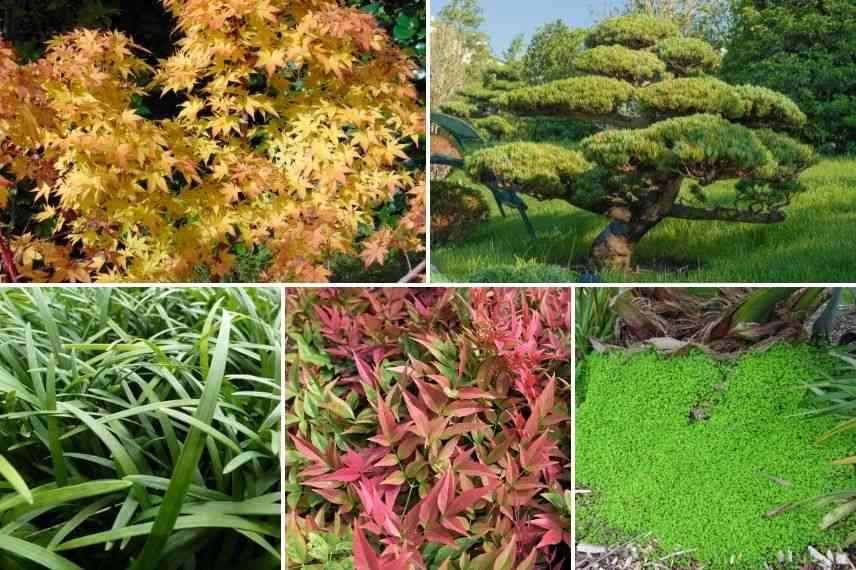
Acer palmatum ‘Sango Kaku’, Niwaki-pruned pine, Ophiopogon planiscapus (photo Guido), Nandina domestica and Helxine soleirolii (photo Leonara Enking)
In pots, for a always welcoming terrace
Snake Beard is a perennial that grows very well in pots and remains decorative all year round without requiring special care. You can certainly plant it alone in a pot, but the ideal is to pair it with other perennials and bushes that will make your balcony or terrace a pleasant place in every season. In a large container, Ophiopogon japonicus forms a groundcover of glossy, evergreen green that highlights shrubs with beautiful coloured foliage such as Japanese Spiraea ‘Goldflame’: with its young foliage of bright orange, summer pink flowers, and rusty hues in autumn, it has many assets and constantly evolves the decor. The acid green foliage marginate with yellow of Physocarpus ‘Anny’s Gold’ creates a stunning contrast when set against a carpet of black Ophiopogon, but you can reverse this contrast by choosing a variety with very dark foliage, such as that of Physocarpus ‘All Black’ on the green of Ophiopogon type. These shrubs also offer a beautiful late spring flowering, followed by decorative berries. Another interesting combination is that of a Japanese Maple, whose foliage changes colour from spring to autumn. While their foliage is interesting, some are also renowned for their very colourful bark in winter, creating attractive scenes all year round. Among the shrubs with evergreen and decorative foliage, consider Pieris, bushy Veronicas (for milder climates), or Skimmia, which also reward you with beautiful flowers or fruit. For a woodland atmosphere, ferns are ideal, as are Hosta or Brunnera, which you should remember to accompany with spring-flowering bulbs, summer-flowering, or autumn-flowering.
–> Design your terrace or balcony with our tips.
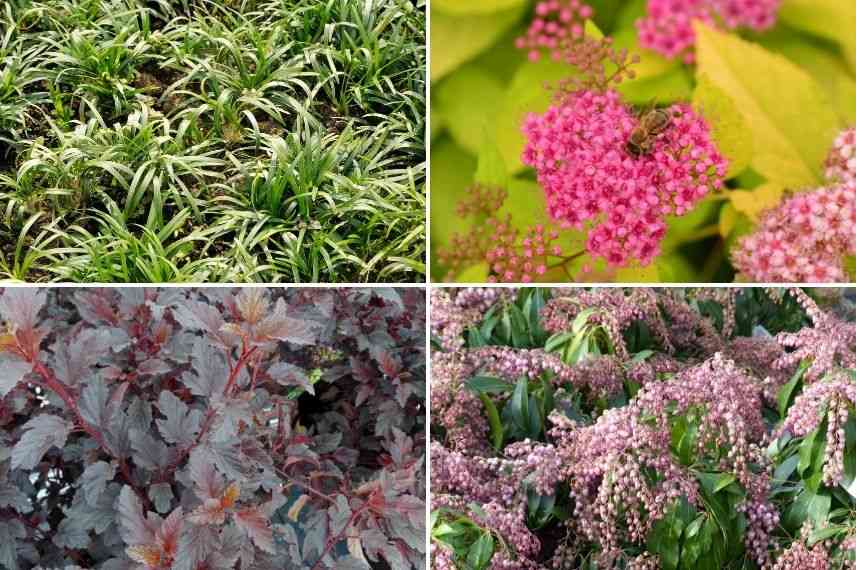
Ophiopogon japonicus, Spiraea japonica ‘Goldflame’, Physocarpus opulifolius ‘All Black’ and Pieris japonica ‘Katsura’
- Subscribe!
- Contents
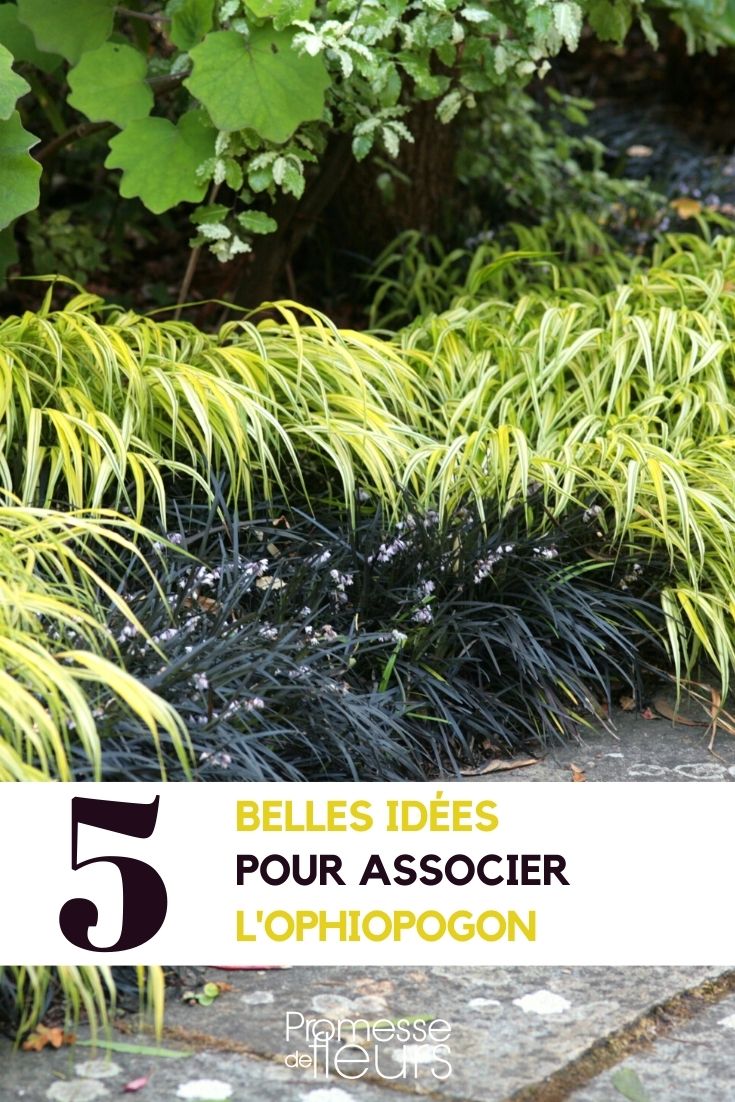































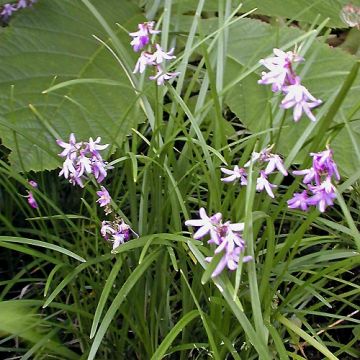

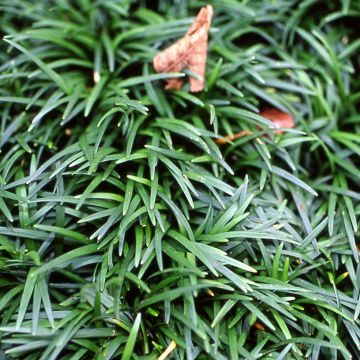
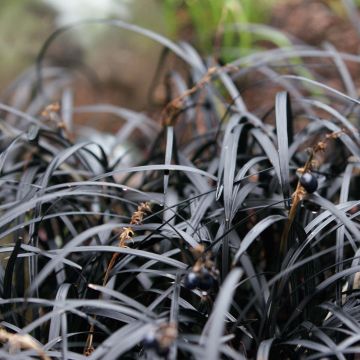
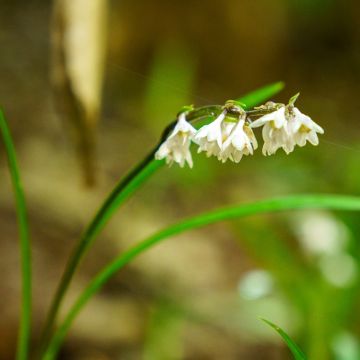
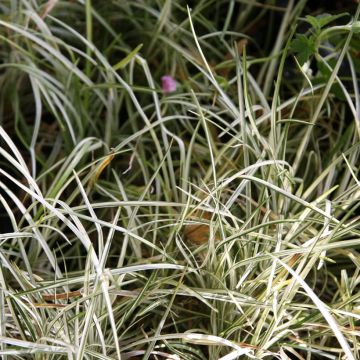

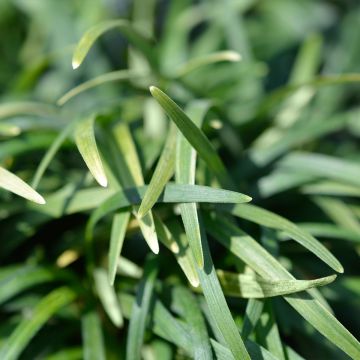
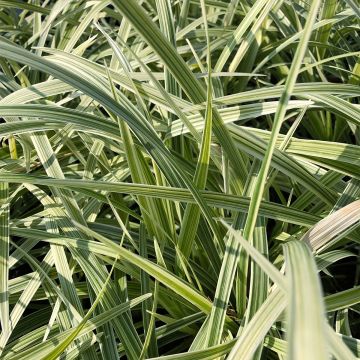

Comments